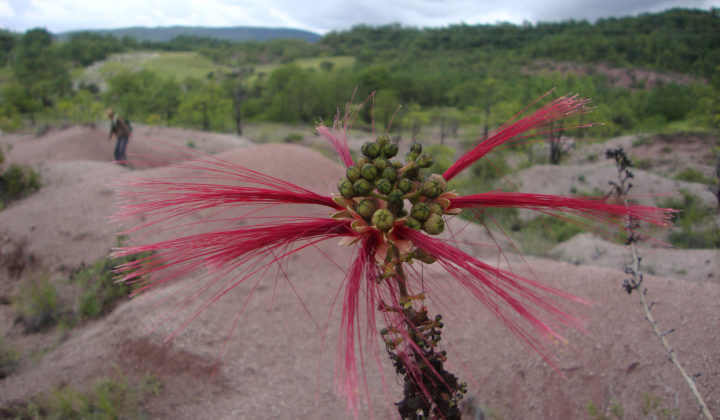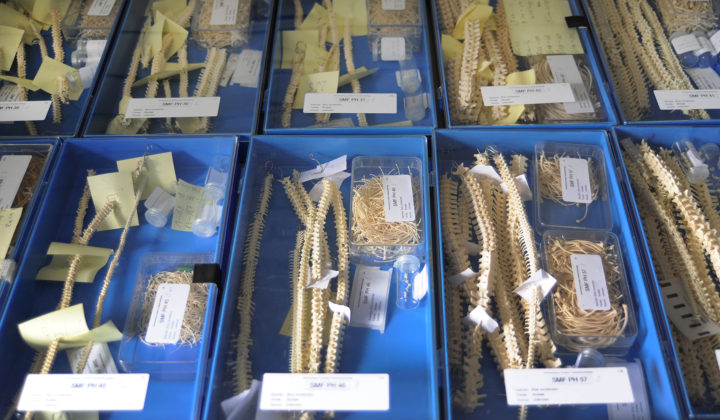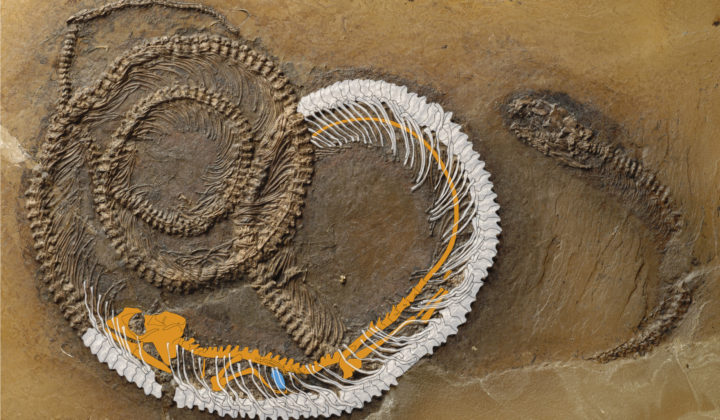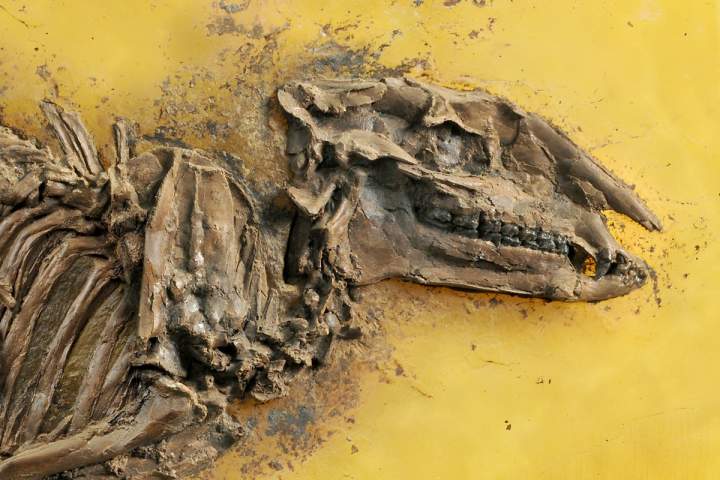
Weitere Informationen zur Person finden Sie unter Vita und Publikationen und unter palherp.net
2016 – present, Deputy Head of Department, Messel Research and Mammalogy, Senckenberg Research Institute
2011 – present, Head of Section Paleoherpetology, Senckenberg Research Institute
2010 – present, Co-speaker for research area Evolution & Biogeography, Senckenberg Research Institute
2008 – 2011, Postdoctoral fellow, Senckenberg Research Institute
2006 – 2008, Postdoctoral fellow, Texas Memorial Museum, The University of Texas at Austin
2000 – 2006, Ph.D., Department of Geology & Geophysics, Yale University
1995 – 2000, B.A., Department of Geology & Geophysics, The University of California at Berkeley
2022
Chuliver, M., Scanferla, A. & Smith, K. T. (2022). Live birth in a 47‑million‑year‑old snake. The Science of Nature 109(56) 1-5. doi:10.1007/s00114-022-01828-3
Smith, K. T. & Scanferla, A. (2022). More than one large constrictor snake lurked around paleolake Messel. Palaeontographica Abteilung A 323(1-3) 75-103. doi:10.1127/pala/2021/0119
Smith, K. T. & Georgalis, G. L. (2022). The diversity and distribution of Paleogene snakes – A review with Commons on Vertebral sufficiency. In GOWER, D. J. & ZAHER, H. (Eds.), The Origin and Early Evolutionary History of Snakes (pp. 55-84): Cambrige University Press.
Smith, K. T., Bhullar, B.-a. S. & Bloch, J. I. (2022). New diminutive Eocene lizard reveals high K-Pg survivorship and taxonomic diversity of stem xenosaurs in North America. American Museum Novitates 3986 1-36. Retrieved from http://hdl.handle.net
2021
Georgalis, G. L., Rabi, M. & Smith, K. T. (2021). Taxonomic revision of the snakes of the genera Palaeopython and Paleryx (Serpentes, Constrictores) from the Paleogene of Europe. Swiss Journal of Palaeontology 140:(18) 1-140. doi:10.1186/s13358-021-00224-0
Smith, K. T. (2021). Paleontology: It´s a bird, it´s a plane, it´s Oculudentavis! Current Biology 31: R948-R971. doi:10.1016/j.cub.2021.06.017
Smith, K. T. & Habersetzer, J. (2021). The anatomy, phylogenetic relationships, and autecology of the carnivorous lizard “Saniwa” feisti Stritzke, 1983 from the Eocene of Messel, Germany. Comptes Rendus Palevol 20:(23) 441-506. doi:10.5852/cr-palevol2021v20a23
Smith, K. T. & Scanferla, A. (2021). A nearly complete skeleton of the oldest definitive erycine boid (Messel, Germany). Geodiversitas 43:(1). doi:10.5252/geodiversitas2021v43a1
Smith, K. T., Comay, O., Maul, L. C., Wegmüller, F., Le Tensorer, J.-M. et al. (2021). A model of digestive tooth corrosion in lizards: experimental tests and taphonomic implications. Nature 11:(12877). doi:10.1038/s41598-021-92326-5
2020
Georgalis, G. L. & Smith, K. T. (2020). Constrictores Oppel, 1811 – the available name for the taxonomic group uniting boas and pythons. Vertebrate Zoology, 70(3), 291-304. doi: 10.26049/VZ70-3-2020-03
Scanferla, A. & Smith, K. T. (2020). Additional anatomical information on the Eocene minute boas Messelophis variatus and Rieppelophis ermannorum (Messel Formation, Germany). Vertebrate Zoology, 70(4), 615-620. doi: 10.26049/VZ70-4-2020-06
Scanferla, A. & Smith, K. T. (2020). Exquisitely preserved fossil snakes of Messel: Insight into the Evolution, Biogeography, Habitat preferences and Sensory ecology of early Boas. Diversity, 12(100). doi:10.3390/d12030100
Smith, K. T. (2020). Rageryx schmidi. Senckenberg – natur forschung museum, 150(10-12), 175-177.
Palci, A., Hutchinson, M. N., Caldwell, M. W., Smith, K. T. & Lee, M. S. Y. (2020). The homologies and evolutionary reduction of the pelvis and hind limbs in snakes, with the first report of ossified pelvic vestiges in an anomalepidid (Liotyphlops beui). Zoological Journal of the Linnean Society.
Zaher, H. & Smith, K.T. (2020). Pythons in the Eocene of Europe reveal a much older divergence of the group in sympatry with boas. Biology Letters 16: 20200735. doi.org/10.1098/rsbl.2020.0735
2019
Smith, K. T. (2019). Eidechse mit vier Augen. Senckenberg – natur forschung museum, 149(1-3), 12-15.
Smith, K. T. & Schwermann, A. (2019). Die ältesten artikulierten Mosasaurier-Überreste aus Deutschland. Archäologie in Westfalen-Lippe, 26-28.
Smith, K. T. Schwermann, A. & Wilmsen, M. (2019). The oldest articulated mosasaurian remains (earliest Turonian) from Germany. Geologie und Paläontologie in Westfalen, 91, 3-23.
Čerňanský, A. & Smith, K. T. (2019). The first juvenile specimen of Eolacerta (Squamata: Eolacertidae) from the early-middle Eocene of the Messel Pit (Germany). Comptes Rendus Palevol, 18, 735-745.
2018
Wedmann, S., D. Uhl, T. Lehmann, R. Garrouste, A. Nel, B. Gomez, K.T. Smith & S.F.K. Schaal (2018) The Konservat-Lagerstätte Menat (Paleocene; France) – an overview and new insights. Acta Geologica 16(2): 189-213. Get PDF
Smith, K.T., B.-A.S. Bhullar, G. Köhler & J. Habersetzer (2018) The only known jawed vertebrate with four eyes and the Bauplan of the pineal complex. Current Biology 28(7): 1101-1107. Get PDF Commentary
Kunin, W., J. Harte, F. He, R.T. Jobe, A. Ostling, C. Polce, A. Šizling, A.B. Smith, K.T. Smith, S. Smart, D. Storch, E. Tjørve, K.-I. Ugland, W. Ulrich & V. Varma (2018) Upscaling biodiversity: estimating the Species-Area Relationship from small samples. Ecological Monographs 88: 170-187. Get PDF
Čerňanský, A. & K.T. Smith (2018) Eolacertidae: a new extinct clade of lizards from the Palaeogene; with comments on the origin of the dominant European reptile group – Lacertidae. Historical Biology 30: 994-1014. Get PDF
Jiménez-Hidalgo, E., R. Guerrero-Arenas & K.T. Smith (2018) Gregorymys veloxikua, the oldest pocket gopher (Rodentia: Geomyidae), and the early diversification of Geomyoidea. Journal of Mammalian Evolution 25: 427-439. Get PDF
2017
Smith, K.T. (2017) The squamation of the Eocene stem-basilisk Geiseltaliellus maarius (Squamata: Iguanidae: Corytophaninae) from Messel, Germany. Salamandra 50: 519-530. Get PDF
Pokrant, F., C. Kindler, M. Vamberger, K.T. Smith & U. Fritz (2017) Grass snakes ( Natrix natrix, N. astreptophora) mimicking cobras display a ‘fossil behavior.’ Vertebrate Zoology 67(2): 261-269. Get PDF
Smith, K.T. (2017) First crocodile-tailed lizard (Squamata: Pan-Shinisaurus) from the Paleogene of Europe. Journal of Vertebrate Paleontology 37: e1313743. Get PDF
2016
Smith, K.T. & A. Scanferla (2016) Fossil snake preserving three trophic levels and evidence for an ontogenetic dietary shift. Palaeobiodiversity and Palaeoenvironments 96: 589-599. Get PDF
Smith, K.T., L.C. Maul, F. Flemming, R. Barkai & A. Gopher (2016) The microvertebrates of Qesem Cave: A comparison of the two concentrations. Quaternary International 398: 233-245. Get PDF
Maul, L.C., A.A. Bruch, K.T. Smith, G. Shenbrot, R. Barkai & A. Gopher (2016) Palaeoecological and biostratigraphical implications of the microvertebrates of Qesem Cave. Quaternary International 398: 219-232. Get PDF
Ceríaco, L.M., E.E. Gutiérrez, A. Dubois et al. (2016) Photography-based taxonomy is inadequate, unnecessary, and potentially harmful for biological sciences. Zootaxa 4196: 435-445. Get PDF
Čerňanský, A.C., J. Klembara & K.T. Smith (2016) Fossil lizard from central Europe resolves the origin of large body size and herbivory in giant Canary Island lacertids. Zoological Journal of the Linnean Society 176: 861-877. Get PDF
Blasco, R., J. Rosell, K.T. Smith, L. Maul, P. Sañudo, R. Barkai & A. Gopher (2016) Tortoises as a dietary supplement for the Middle Pleistocene hominids of Qesem Cave, Israel. Quaternary Science Reviews 133: 165-182. Get PDF
Scanferla, C.A., K.T. Smith & S.F.K. Schaal (2016) Revision of the cranial anatomy and phylogenetic relationships of the Eocene minute boas Messelophis variatus and Messelophis ermannorum (Serpentes, Booidea). Zoological Journal of the Linnean Society 176: 182-206. Get PDF
2015
Maul, L.C., K.T. Smith, G. Shenbrot, A. Bruch, F. Wegmüller & J.-M. le Tensorer (2015) Microvertebrates from unit G/layer 17 of the archaeological site of Hummal (El Kowm, Central Syria). Preliminary results. Le Anthropologie 119: 676-686. Get PDF
Smith, K.T. & M. Wuttke (2015) Avian pellets from the late Oligocene of Enspel, Germany – ecological interactions in deep time. Palaeobiodiversity and Palaeoenvironments 95: 103-113. Get PDF
Jiménez-Hidalgo, E., K.T. Smith, R. Guerrero-Arenas & J. Alvarado-Ortega (2015) The first late Eocene continental faunal assemblage from tropical North America. Journal of South American Earth Sciences 57: 39-48. Get PDF
2014
Čerňanský, A.C., K.T. Smith & J. Klembara (2014) Variation in the position of the jugal medial ridge among lizards (Reptilia: Squamata): its functional and taxonomic significance. The Anatomical Record 297: 2262-2272. Get PDF
2013
Horáček, I., L.C. Maul, K.T. Smith, R. Barkai & A. Gopher (2013) Bat remains (Mammalia, Chiroptera) from the Middle Pleistocene site of Qesem Cave, Israel: first evidence of a Pleistocene fruit bat in the Near East. Palaeontologia Electronica 16.3.23A. Get PDF
Smith, K.T. & J.A. Gauthier (2013) Early Eocene lizards of the Wasatch Formation near Bitter Creek, Wyoming: diversity and paleoenvironment during an interval of global warming. Bulletin of the Peabody Museum of Natural History 54(2): 135-230. Get PDF [corrigendum]
Smith, K.T., L.C. Maul, R. Barkai & A. Gopher (2013) To catch a chameleon, or actualism vs. natural history in the taphonomy of the microvertebrate fraction at Qesem Cave, Israel. Jounal of Archaeological Science 40(8): 3326-3339. Get PDF
Smith, K.T. (2013) New contraints on the evolution of the snake clades Ungaliophiinae, Loxocemidae and Colubridae (Serpentes), with comments on the fossil history of erycine boids in North America. Zoologischer Anzeiger 252: 157-182. Get PDF
2012
Parham, J.F., P.C.J. Donoghue, C.J. Bell, T.D. Calway, J.J. Head, P.A. Holroyd, J.G. Inoue, R.B. Irmis, W.G. Joyce, D.T. Ksepka, J.S.L. Patane, N.D. Smith, J.E. Tarver, M. Van Tuinen, Z.H. Yang, K.D. Angielczyk, J. Greenwood, C.A. Hipsley, L. Jacobs, P.J. Mackovicky, J. Müller, K.T. Smith, J.M. Theodor, R.C.M. Warnock & M.J. Benton (2012) Best practices for applying paleontological data to molecular divergence dating analyses. Systematic Biology 61: 346-359. Get PDF
Smith, K.T. & M. Wuttke (2012) From tree to shining sea: Taphonomy of the arboreal lizard Geiseltaliellus maarius from Messel, Germany. Palaeobiodiversity and Palaeoenvironments 92(1): 45-65. Get PDF
2011
Smith, K.T. (2011) The phylogenetic affinity of the fossil agamid lizard Tinosaurus. Bonner Zoologische Monographien 57: 9-28. Get PDF
Smith, K.T. (2011) The long-term history of dispersal among lizards in the early Eocene: New evidence from a microvertebrate assemblage in the Bighorn Basin of Wyoming, U.S.A. Palaeontology 54(6): 1243-1270. Get PDF
Smith, K.T. (2011) Oreithyia, a replacement name for Orithyia Smith, 2011, nec Orithyia Fabricius, 1798. Bulletin of the Peabody Museum of Natural History 52(2): 273. Get PDF
Smith, K.T. (2011) The evolution of mid-latitude faunas during the Eocene: Late Eocene lizards of the Medicine Pole Hills reconsidered. Bulletin of the Peabody Museum of Natural History 52(1): 3-105. Get PDF
Maul, L., K.T. Smith, R. Barkai, A. Barash, P. Karkanas, R. Shahack-Gross & A. Gopher (2011) Microfaunal remains at Middle Pleistocene Qesem Cave, Israel: preliminary results on small vertebrates, environment and biostratigraphy. Journal of Human Evolution 60(4): 464-480. Get PDF
Smith, K.T., S. Schaal, W. Sun & C.T. Li (2011) Acrodont iguanians (Squamata) from the middle Eocene of the Huadian Basin of Jilin Province, China, with a critique of the taxon “ Tinosaurus”. Vertebrata PalAsiatica 49(1): 69-84. Get PDF
2009
Smith, K.T. (2009) Eocene lizards of the clade Geiseltaliellus from Messel and Geiseltal, Germany, and the early radiation of Iguanidae (Reptilia: Squamata). Bulletin of the Peabody Museum of Natural History 50(2): 219-306. Get PDF
Smith, K.T. (2009) A new lizard assemblage from the earliest Eocene (zone Wa0) of the Bighorn Basin, Wyoming, U.S.A.: Biogeography during the warmest interval of the Cenozoic. Journal of Systematic Palaeontology 7(3): 299-358. Get PDF [corrigendum]
2008
Smith, K.T. (2008) On the measurement of beta diversity: An analog of the species–area relation for point sources. Evolutionary Ecology Research 10(7): 987-1006. Get PDF
Ifrim, C., M.-C. Buchy, K.T. Smith & S. Giersch (2008) Paleoenvironment and preliminary description of early Turonian (Late Cretaceous) aquatic squamates from Vallecillo, north-eastern Mexico. Fort Hays Studies 3: 47-62. Get PDF
Smith, K.T., B.-A.S. Bhullar & P.A. Holroyd (2008) Earliest African record of the Varanus stem-clade (Squamata: Varanidae) from the early Oligocene of Egypt. Journal of Vertebrate Paleontology 28(3): 909-913. Get PDF
Bhullar, B.-A.S. & K.T. Smith (2008) A helodermatid dentary from the Miocene of Florida, the evolution of the dentary in Helodermatidae, and comments on dentary morphology in Varanoidea. Journal of Herpetology 42(2): 286-302. Get PDF
Smith, K.T. & M.-C. Buchy (2008) A new aigialosaur (Squamata: Anguimorpha) with soft-tissue preservation from the Upper Cretaceous of Nuevo León, Mexico. Journal of Vertebrate Paleontology 28(1): 85-94. Get PDF
2006
Smith, K.T. (2006) A diverse new assemblage of late Eocene squamates (Reptilia) from the Chadron Formation, North Dakota, U.S.A. Palaeontologia Electronica 9.2.5A. Get PDF
2005
Stinnesbeck, W., C. Ifrim, H. Schmidt, A. Rindfleisch, M.-C. Buchy, E. Frey, A. H. González González, H. Porras-Muzquiz, L. Cavin & K.T. Smith (2005) A new lithographic limestone deposit in the Upper Cretaceous Austin Group at El Rosario, county of Múzquiz, Coahuila, northeastern Mexico. Revista Mexicana de Ciencias Geológicas 22: 401-418. Get PDF
Buchy, M.-C., K.T. Smith, E. Frey, W. Stinnesbeck, A. H. González González, C. Ifrim, J. G. López-Oliva & H. Porras-Muzquiz (2005) Annotated catalogue of marine squamates (Reptilia) from the Upper Cretaceous of northeastern Mexico. Netherlands Journal of Geosciences 84: 195-206. Get PDF
2003
Smith, K.T. & P.A. Holroyd (2003) Rare taxa, biostratigraphy, and the Wasatchian-Bridgerian boundary in North America. Geological Society of America Special Paper 369: 501-511. Get PDF
2001
Smith, K.T. (2001) Reassessing the Lambdotherium first appearance datum (Wasatchian, early Eocene) in the Bighorn Basin, Wyoming. PaleoBios 21: 1-11. Get PDF
1999
Guralnick, R. & K. Smith (1999) Historical and biomechanical analysis of integration and dissociation in molluscan feeding, with special emphasis on the true limpets (Patellogastropoda: Gastropoda). Journal of Morphology 241: 175-195. Get PDF
Books
Smith, K.T., S.F.K. Schaal & J. Habersetzer, eds. (2018) Messel: An Ancient Greenhouse Ecosystem. Schweizerbart, Stuttgart. Get book
Schaal, S.F.K., K.T. Smith & J. Habersetzer, eds. (2018) Messel: Ein fossiles Tropenökosystem. Schweizerbart, Stuttgart. Get book
Book chapters
Smith, K.T. (In press) Pan-Iguania. In K. de Queiroz, P.D. Cantino & J.A. Gauthier (eds.), Phylonyms: A Companion to the PhyloCode. University of California Press, Los Angeles.
Wedmann, S., J. Habersetzer, T. Lehmann, I. Ruf, S.F.K. Schaal & K.T. Smith (2018) Messel research – methods und concepts; pp. 34-41 in K.T. Smith, S.F.K. Schaal & J. Habersetzer (eds.), Messel: An Ancient Greenhouse Ecosystem. Schweizerbart, Stuttgart.
Smith, K.T., A. Čerňanský, A. Scanferla & S.F.K. Schaal (2018) Lizards and snakes – warmth-loving sunbathers; pp. 122-147 in K.T. Smith, S.F.K. Schaal & J. Habersetzer (eds.), Messel: An Ancient Greenhouse Ecosystem. Schweizerbart, Stuttgart.
Cadena, E.A., W.G. Joyce & K.T. Smith (2018) Turtles – armored survivalists; pp. 148-157 in K.T. Smith, S.F.K. Schaal & J. Habersetzer (eds.), Messel: An Ancient Greenhouse Ecosystem. Schweizerbart, Stuttgart.
Smith, K.T., T. Lehmann, G. Mayr, N. Micklich, R. Rabenstein & S. Wedmann (2018) The Messel ecosystem; pp. 302-313 in K.T. Smith, S.F.K. Schaal & J. Habersetzer (eds.), Messel: An Ancient Greenhouse Ecosystem. Schweizerbart, Stuttgart.
Wedmann, S., J. Habersetzer, T. Lehmann, I. Ruf, S.F.K. Schaal & K.T. Smith (2018) Messelforschung – Methoden und Begriffe; pp. 34-41 in S.F.K. Schaal, K.T. Smith & J. Habersetzer (eds.), Messel: Ein fossiles Tropenökosystem. Schweizerbart, Stuttgart.
Smith, K.T., A. Čerňanský, A. Scanferla & S.F.K. Schaal (2018) Echsen und Schlangen – wärmeliebene Sonnenanbeter; pp. 122-147 in S.F.K. Schaal, K.T. Smith & J. Habersetzer (eds.), Messel: Ein fossiles Tropenökosystem. Schweizerbart, Stuttgart.
Cadena, E.A., W.G. Joyce & K.T. Smith (2018) Schildkröten – gepanzerte Überlebenskünstler; pp. 148-157 in S.F.K. Schaal, K.T. Smith & J. Habersetzer (eds.), Messel: Ein fossiles Tropenökosystem. Schweizerbart, Stuttgart.
Smith, K.T., T. Lehmann, G. Mayr, N. Micklich, R. Rabenstein & S. Wedmann (2018) Das Messeler Ökosystem; pp. 302-313 in S.F.K. Schaal, K.T. Smith & J. Habersetzer (eds.), Messel: Ein fossiles Tropenökosystem. Schweizerbart, Stuttgart.
Buchy, M.-C. & K.T. Smith (2011) New portions of the holotype of Vallecillosaurus donrobertoi (Squamata, Mosasauroidea) from the early Turonian (Upper Cretaceous) of Mexico; pp. 47–55 in J. Calvo, J. Porfiri, B. Gonzalez Riga & D. Dos Santos (eds.), Paleontología y dinosaurios desde América Latina. Universidad Nacional de Cuyo, Mendoza, Argentina.
Popular science
Smith, K.T. (2018) Lizards and skeletons. Flicker Bulletin 36.
Franzen, J.L., K. Smith & J. Habersetzer (2017) Krokodil gegen Urpferd. Natur – Forschung – Museum 147(1/2): 34-43.
Smith, K.T. (2016) Eat [and] be eaten: the ancient ecosystem of Messel. pp. 102-105 in The Munich Show. Hidden Treasures of the Museums. Wachholtz, Kiel.
Cadena, E. & K.T. Smith (2016) Vorstoß ins Mark: REM-Technologie macht 48 Millionen Jahre alte Knochenzellen und Blutgefäße sichtbar. Natur – Forschung – Museum 146(3/4): 78-85.
Maul, L.C. & K.T. Smith (2014) Von Mäusen, Echsen und Menschen. Natur – Forschung – Museum 144(7/8): 284-285.
Smith, K.T. & S. Wedmann (2013) Unerforschte Vielfalt in der Grube Messel. Natur – Forschung – Museum 143(7/8): 230-235.
Smith, K.T. (2010) Ein außergewöhnlicher Fund aus der Grube Messel. Senckenberg Jahrbuch 2007-2008: 35.

Arbeitsschwerpunkte: 2D und 3D-basierte Untersuchungen an Messeler und rezenten Fledermäusen, Mitarbeiterin im DFG-Projekt Entwicklung neuer Digitalisierungsstandards
ab 2018 Strahlenschutzbeauftragte und kommissarische Sektionsleiterin Radiologie sowie Leiterin Arbeitsgruppe Paläochiropterologie mit nationalen und internationalen Kooperationen
ab 2013 Stellvertretende Strahlenschutzbeauftragte Senckenberg Frankfurt und Messel
2008-2017 Leitung der „Senckenberg Friends for Seniors“
2006-2010 Lehrerfortbildungen „Weltnaturerbe Grube Messel“ in Zusammenarbeit mit der Bertha Heraeus und Kathinka Platzhoff Stiftung
1996-2004 Lehraufträge Goethe Universität Frankfurt am Main, FB Erziehungswissenschaft/Didaktik
ab 1995 verschiedene Werkverträge und Projekte in der Abteilung Messelforschung: Tropical Lake Project; Elektronische Publikationen (1999: Messel-Courier 216 – erstes elektronisches Buch bei Senckenberg; 2004: Messel-Courier 252 – erster Courier mit Begleit-CD; 2011: Messel-DVD – erste Senckenberg DVD); Projekt Multimedia-Materialien Messel (M4); Projekt Erlebnisgestaltung Messel (gefördert durch Nationale UNESCO-Welterbestätten)
1995 Promotion Goethe Universität Frankfurt am Main, FB Biologie
Rabenstein, R. & Stiefel, D. (2023). Einsatz von Röntgenmethoden im Natur- und Artenschutz am Beispiel von Fledermäusen. In STADTLER, J. (Ed.), Biodiversität und Klima – Vernetzung der Akteure in Deutschland XVIII : Dokumentation der 18. Tagung (Vol. 652, pp. 49-53).
Rabenstein, R. & Stiefel, D. (2022). Rare dental anomalies in two sympatric European bat species (Pipistrellus spp.). Bulletin of the International Association for Paleodontology 16(2) 284-291. Retrieved from https://hrcak.srce.hr/288337
Rabenstein, R. & Stiefel, D. (2020) Lethal teeth anatomy in Pipistrellus – a single case? Radiological investigations in extant bats. — German Bat Research Meeting 2020: 26.
Morlo, M., Bastl, K., Habersetzer, J., Engel, T., Lischewsky, B., Lutz, H., von Berg, A., Rabenstein, R. & Nagel, D. (2020) The apex of amphicyonid hypercarnivory: solving the riddle of Agnotherium antiquum Kaup, 1833 (Mammalia, Carnivora). — Journal of Vertebrate Paleontology, published online: 20 Feb 2020. doi: 10.1080/02724634.2019.1705848.
Rabenstein, R. & Habersetzer, J. (2019) Fledermäuse, Ameisenbär und Urpferd – Mit Röntgenstrahlen in eine Lebenswelt vor 50 Millionen Jahren: 116–124. — In: U. Busch & W. Rosendahl [Hrsg] Die Welt im Durchblick – Wunder moderner Röntgentechnik, wbg Theiss: 160 Seiten. Darmstadt (Schweizerbart).
Wehner, R., Rabenstein, R. & Habersetzer, J. (2019) Long-leggedness in cataglyphoid Baltic amber ants. — Palaeobiodiversity and Palaeoenvironments, 100 (1): 79–93. published online: 08 March 2019, doi: 10.1007/s12549-019-00372-9.
Rabenstein, R., Habersetzer, J., Lehmann, T. Ruf, I., Gunnell, G.F.† & Rose. K.D. (2018) Forelimb anatomy of Eurotamandua joresi from the middle Eocene of Messel, Germany, based on computed tomography: systematic implications. — Journal of Vertebrate Paleontology: 201A; Albuquerque.
Habersetzer, J., Rabenstein, R. & Gunnell, G.F. † (2018) Fledermäuse – nächtliche Jäger mit Echoortung: 248–261. — In: Schaal, S.F.K., Smith, K.T. & Habersetzer, J. [Hrsg] Messel – Ein fossiles Tropenökosystem. Schweizerbart und Senckenberg Gesellschaft für Naturforschung, 355 Seiten.
Habersetzer, J., Rabenstein, R. & Gunnell, G.F. † (2018) Bats – Highly Specialized Nocturnal Hunters with Echolocation: 248–261. — In: Smith, K.T., Schaal, F.K. & Habersetzer, J. [eds] Messel – An Ancient Greenhouse Ecosystem. Schweizerbart and Senckenberg Gesellschaft für Naturforschung, 355 pages.
Schneider, J. V., Negraschis, V., Habersetzer, J., Rabenstein, R., Wesenberg, J., Wesche, K. & Zizka, G. (2018) Taxonomic diversity masks leaf vein-climate relationships: lessons from herbarium collections across a latitudinal rainfall gradient in West Africa. — Botany Letters 165 (3–4): 384–395; doi: 10.1080/23818107.2017.1421480.
Schneider, J.V., Rabenstein, R., Wesenberg, J., Wesche, K., Zizka, G. & Habersetzer, J. (2018) Improved non-destructive 2D and 3D X-ray imaging of leaf venation. — Plant Methods 14 (7); doi: 10.1186/s13007-018-0274-y.
Smith, K.T., Lehmann, T., Mayr, G., Micklich, N., Rabenstein, R. & Wedmann, S. (2018) Das Ökosystem Messel: 302–313. — In: Schaal, S.F.K., Smith, K.T. & Habersetzer, J. [Hrsg] Messel – Ein fossiles Tropenökosystem. Schweizerbart und Senckenberg Gesellschaft für Naturforschung, 355 Seiten.
Smith, K.T., Lehmann, T., Mayr, G., Micklich, N., Rabenstein, R. & Wedmann, S. (2018) The Messel Ecosystem: 302–313. — In: Smith, K.T., Schaal, S.F.K. & Habersetzer, J. [eds] Messel – An Ancient Greenhouse Ecosystem. Schweizerbart and Senckenberg Gesellschaft für Naturforschung, 355 pages.
Wuttke, M., Rabenstein, R. & Vinther, J. (2018) Im Tod vereint – die Messeler Grabgemeinschaft: 24–33. — In: Schaal, S.F.K., Smith, K.T. & Habersetzer, J. [Hrsg] Messel – Ein fossiles Tropenökosystem. Schweizerbart und Senckenberg Gesellschaft für Naturforschung, 355 Seiten.
Wuttke, M., Rabenstein, R. & Vinther, J. (2018) Joined in Death: the Burial Community of Messel: 24–33. — In: Smith, K.T., Schaal, S.F.K. & Habersetzer, J. [eds] Messel – An Ancient Greenhouse Ecosystem. Schweizerbart and Senckenberg Gesellschaft für Naturforschung, 355 pages.
Schneider, J.V., Habersetzer, J., Rabenstein, R., Wesenberg, J., Wesche, K. & Zizka, G. (2016) Water supply and demand remain coordinated during breakdown of the global scaling relationship between leaf size and major vein density. — New Phytologist 214 (1): 473–486; doi:10.1111/nph.14382.
Colleary, C., Dolocan, A., Gardner, J., Singha, S., Wuttke, M., Rabenstein, R., Habersetzer, J., Schaal, S., Feseha, M., Clemens, M., Jacobs, B. F., Currano, E. D., Jacobs, L. L., Sylvestersen, R. L., Gabbott, S. E. & Vinther, J. (2015) Chemical, experimental, and morphological evidence for diagenetically altered melanin in exceptionally preserved fossils. — Proceedings of the National Academy of Sciences of the United States of America 104 (2): 565–569; doi: 10.1073/pnas.1509831112.
Rabenstein, R. (2014) Paläontologie, Geologie, Biologie – Pädagogisches Gesamtkonzept des Projektes „Erlebnisgestaltung Weltnaturerbe Grube Messel“. — Schriftenreihe der Deutschen Gesellschaft für Geowissenschaften 85: 639–640; Stuttgart (Schweizerbart).
Rabenstein, R. & Schaal, S. (2012) Erlebnisgestaltung Weltnaturerbe Grube Messel – Geologische Aspekte. — Schriftenreihe der Deutschen Gesellschaft für Geowissenschaften 79: 39–41; Stuttgart (Schweizerbart).
Schaal, S. F. K. & Rabenstein, R. (2012) Der Tagebau Messel in Linien und Zahlen – Drei aktuelle Messel-Karten zum Download. — Senckenberg – Natur, Forschung, Museum 142 (11/12): 376–377.
Rabenstein, R. (2011) Fledermausführungen im Weltnaturerbe Grube Messel. — Begegnung Zoo, Zoopädagogik aktuell (26): 42–44
Habersetzer, J. & Rabenstein, R. (2011) Studies in Taphonomy of Extant and Messel Bats. — Journal of Vertebrate Paleontology: 120A; Las Vegas.
Rabenstein, R., Habersetzer, J. & Schlosser-Sturm, E. (2011) 3D reconstructions of Eocene and extant bats – Multimedia materials for public activities in the Year of the Bat 2011. — In: Lehmann, T. & Schaal, S.F.K. [eds] The World at the Time of Messel. Frankfurt (SGN): 133–134.
Rabenstein, R. & Schaal, S. (2011) Messeler Fossiliensammlungen – Einblicke in einen 47 Millionen Jahre alten Lebensraum. — Senckenberg – Natur, Forschung, Museum 141 (3/4): 90–95; Frankfurt a.M.
Sparwasser, K., Habersetzer, J. & Rabenstein, R. (2011) Urzeit am Geistersee & Ida completed. — DVD 70 Min. + Bonusmaterial 30 Min. 978-3-929907-85-8 (ISBN). erhältlich im Schriftentausch
Rabenstein, R. (2010) Terrestrial Eocene and the Mesel Pit Fossil Site – Specific Educational Projects on Fossils of the World Heritage Site. — Schriftenreihe der Deutschen Gesellschaft für Geowissenschaften 68: 450–451; Stuttgart (Schweizerbart).
Rabenstein, R., Diehl, D., Habersetzer, J., Schlosser-Sturm, E. (2010) Nocturnal Hunters in the Messel Pit – Fossil und Extant Bats of the UNESCO World Heritage Site (Hesse, Germany). — Schriftenreihe der Deutschen Gesellschaft für Geowissenschaften 68: 451–452, Schweizerbart, Stuttgart
Zahorka, H., Wiriadinata, H. & Rabenstein, R. (2008) Botanic expedition to the mysterious Laut Tinggal in the remote cloud forests of West Sumatra, Indonesia. — Folia malaysiana 91 (1): 51–62.
Rabenstein, R. & Habersetzer, J. (2007) Von original bis multimedial – Senckenbergische Beiträge für das Besucherzentrum am Weltnaturerbe Grube Messel. — Schriftenreihe der Deutschen Gesellschaft für Geowissenschaften 51: 157–167; Stuttgart (Schweizerbart).
Rabenstein, R., Habersetzer, J. & Mohrmann, E. (2007) Rekonstruktion des Messeler Halbaffen Europolemur kelleri im Rahmen senckenbergischer Multimedia-Projekte. — Hallesches Jahrbuch für Geowissenschaften 23: 97–109; Halle (Saale).
Rabenstein, R., Habersetzer, J., Franzen, J.L. & Weißbrod, C. (2007) Europolemur kelleri – Der Messeler Halbaffe. — Natur und Museum 137 (3/4): 78–79; Frankfurt a. M.
Rabenstein, R. (2007) Messel – Erste Schritte: Eine paläontologische Einführung für 5- bis 8-jährige Kinder in Deutschlands Weltnaturerbe. — Schriftenreihe der Deutschen Gesellschaft für Geowissenschaften 51: 147–156; Stuttgart (Schweizerbart).
Rabenstein, R. (2006) Messel aktiv und interaktiv – Praxisbeispiele paläontologischer Führungen im Rahmen eines pädagogischen Gesamtkonzepts für das Weltnaturerbe. — Schriftenreihe der Deutschen Gesellschaft für Geowissenschaften 42: 47–50; Schweizerbart, Stuttgart.
Rabenstein, R. (2005) Fossilien aus dem Weltnaturerbe Grube Messel im naturwissenschaftlichen Unterricht. — In: Bayrhuber, H. & Hlawatsch, S. [Hrsg] System Erde – Unterrichtsmaterialien für die Sekundarstufe II (CD-ROM), Leibniz-Institut für die Pädagogik der Naturwissenschaften (IPN), Kiel: 1–3.
Rabenstein, R., Usman, R. & Schaal, S. (2004) Suche nach rezenten Seen als Modelle für den eozänen Lebensraum von Messel. — Courier Forschungsinstitut Senckenberg 252: 115–138; Frankfurt a. M.
Rabenstein, R., Habersetzer, J. & Schaal, S. (2004) Ein internetbasierter Überblick zum Weltnaturerbe Grube Messel. — Courier Forschungsinstitut Senckenberg 252: 219–223; Frankfurt a. M.
Krassmann, T. & Rabenstein, R. (2004) Kugelpanorama-Ansichten des Weltnaturerbes Grube Messel. — Courier Forschungsinstitut Senckenberg 252: 225–227; Frankfurt a. M.
Rabenstein, R. & Farouk (1996) Water quality parameters of some lakes in West-Sumatra and Kerinci Seblat National Park (Jambi Province). — Fisheries Journal Garing 5 (1): 11–19.
Rabenstein, R. & Schaal, S. (1995) Eocene Lake Messel and its comparability with recent lakes. — In: Noe-Nygaard, N. & Wiese Christensen, U. [eds] First International Limno-geological Congress – Research and research methods in ancient and modern basins: 109A; Copenhagen. ISBN 87 89980 08 5



